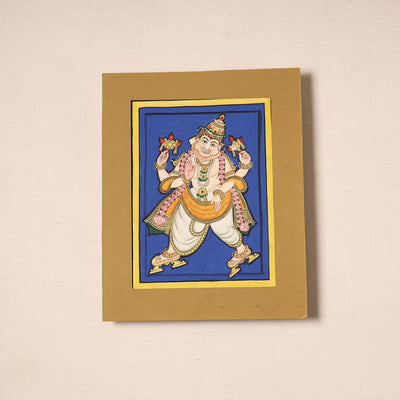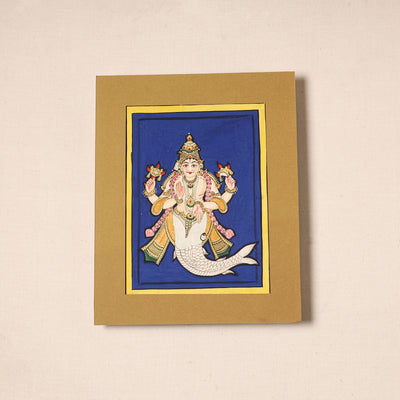India is a place with a rich and ancient history that encompasses the stories of people from different walks of life along with their various forms of art. As a country with thousands of years of culture being handed down from one generation to the next, we have a myriad variety of art to showcase, from cave paintings and temple architecture to intricate designs and textiles from the Mughal times. One such art form is the Indian Mysore folk art which is an important South Indian form of painting. It is a type of folk art that represents the culture and traditions of the people of Mysore, in the state of Karnataka. Mysore paintings involve attention-grabbing vibrant colours and intricate designs painted by talented artists. This art not only has an aesthetic value, but it tells the story of a very unique and interesting culture of the people of Southern India.

History of Mysore Painting
Mysore painting history finds its origins in Karnataka during the late 17th century when it was ruled by the Wodeyar dynasty. Although it is said to have been influenced by the Vijayanagar school of art under the Vijayanagar empire in the 13th century, the true evolution of this art form occurred under the Wodeyar dynasty, particularly under the rule of Raja Krishna Raja Wodeyar. Even in the midst of their kingdom being lost to Tipu Sultan and then regained by the Wodeyars, the Mysore folk art survived, but the artists dispersed to various different parts after the death of the king. In 1875, the Chitrakala school and Jagan Mohan Palace were established to revive this art again and in the 20th century, notable artists such as Ravi Verma incorporated Mysore paintings into their art that maintained its popularity.
Mysore Paintings
From Karnataka
Process of Mysore Painting
The process of making a Mysore painting was quite different from the paintings we are used to seeing today. It involved preparing a canvas, sketching the design, filling in the colours and then finally embellishing the painting with gold leaf.
Firstly, the artist would prepare a cloth canvas as a material for the painting by coating it with gum or glue to make it smooth. Then the artist would use charcoal or a pencil to create the outline of the painting. This was a step that required a lot of precision and skill.
Then the next part involved filling in vibrant colours into the outline by use of natural dyes and pigments such as those obtained from plants, flowers and leaves. These colours were again applied systematically using brushes made from the hair of animals.
The last step involved the use of gold leaf to embellish the painting, which was characteristic of the Mysore traditional paintings. This gave a striking lustrous appearance to the Mysore painting.

Image Credit:- D'source
Themes of Mysore Painting
There were a variety of themes that the artists touched upon in this art of Karnataka. The dominant themes were of Hindu mythology, such as Gods and Goddesses, the narration of epics like the Mahabharata and Ramayana and the various stories involved in them. There were also love stories of Radha-Krishna, portraits of deities and royal figures and everyday natural scenes such as landscapes and animals.

You Might Like Reading:
Aipan Art of Uttarakhand
The Mesmerizing World of Tanjore Art
The Pictorial Narratives of Cheriyal Paintings
Mysore Painting Artists
The craftsmanship involved in making the Mysore traditional paintings was unparalleled and truly skilful. They dedicated their entire lives to learning and teaching this art form, and have passed it on to several generations, which is why we can still see and admire the Mysore folk art.
Some of the famous artists of Mysore Painting are:
- Sri K.S Shreehari - Famous for his artworks ‘Virata Vishwaroopa’ and ‘Panchanaari-Turuga’
- M. Ram Narsaiah - famous artist for the Mysore Royal family. His daughter Chandrika continues with his legacy.
- B.P Ramakrishna
-
R.G Singh
They had meticulous craftsmanship that only comes with utmost dedication and practice, which is why their work is deemed so valuable and the art so sought after even today.

Image Credit:- D'source
Mysore Painting Today
This art of Karnataka continues to be popular and cherished throughout the country and the world even today. There are still several skilled artists who have dedicated their lives to this art and painted their folk art passionately. Their livelihood is kept up due to the strong demand for this folk art by collectors and those interested to keep traditional Indian art forms alive. There is a massive effort to preserve this ancient art form through exhibitions, collaborations and by simply spreading awareness about our rich history.

You Might Like Reading:
Kalighat Painting: The Folk Art from Bengal
The Madhubani Painting Heritage
Pichwai Art: The Folk Art of Nathdwara, Rajasthan
Conclusion
We hope you were inspired and enlightened by the knowledge about this priceless art of Karnataka and were impressed by its rich history and continuing traditions. It is a true marvel for such cherished art forms to be practised and enthusiastically purchased to this day, which is why we at iTokri are proud to present our collection of Mysore folk art. You can support the talented craftsmen behind this art by buying their paintings and taking our journey forward. You can find various Indian Folk Arts on our site created by skilled artisans. Your favourite Indian handicraft store online, iTokri has something for everyone’s choice.
FAQs on Mysore Paintings
- What is the traditional art in Mysore?
The traditional art in Mysore is Mysore Painting which involves making vibrant coloured paintings embellished with gold leaf.
- Is Mysore painting folk art?
Yes, it is folk art which expresses the rich cultural heritage of that area.
- Why is Mysore Painting famous?
Mysore painting is popular due to its spectacular designs, vibrant colours, intricate artwork and gold leaf embellishment.

























Leave a comment (all fields required)